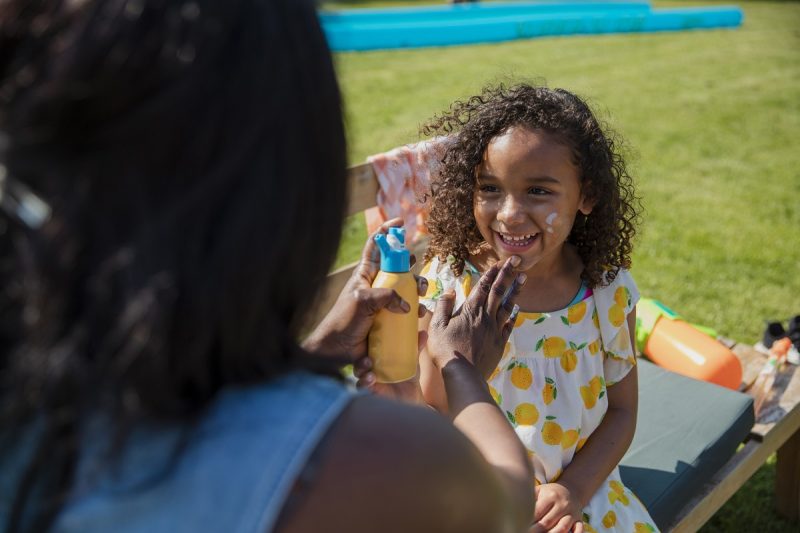Summer has arrived and with it so have dreams of beach vacations, trips to the waterpark and outdoor activities. After months of winter’s colder temperatures, you’re ready to get outside in search of that warm feel of sun on your skin and the resulting “healthy glow.”
Sure, the sun feels good, but while everyone needs limited sun exposure to produce vitamin D to strengthen bones, unprotected exposure to the sun’s ultraviolet rays can damage skin and increase the risk for skin cancer.
But there’s no need to be a recluse, says Dr. Charlene Lam, a Penn State Health dermatologist. Just be smart about your time in the sun and protect your skin by taking a few preventive steps, including routinely using sunscreen.
HOW SUNSCREEN KEEPS YOU SAFE
“It is not just the day out at the beach or waterpark when you need sunscreen, but every time you go out – when you get the mail, walk the dog – all of that exposure to the sun can add up to damage and lead to skin cancer, aging skin, dark spots and wrinkles,” she said. “Although there is no single method that protects you perfectly, there are different modalities we can be smart about and adopt into our lifestyle as daily habits.”
One is the regular use of sunscreen, which protects your skin by absorbing or reflecting the sun’s ultraviolet (UV) rays that damage skin cells.
“There are two types: UVB rays, which cause sunburn and play a key role in skin cancer, and UVA rays, which cause skin damage that leads to tanning, aging of skin and wrinkles,” Lam said. “That’s why it’s important to choose a broad-spectrum sunscreen that protects you from both.”
She also recommends choosing a sunscreen with a sun protection factor – or SPF – of 30 or higher. Although high SPF sunscreens protect from burning for longer periods of time than those with lower SPF, they can give the user a false sense of security.
“Sometimes what I see are people who use an SPF 50 will stay in the sun longer and won’t reapply. They end up getting more sun damage, and it defeats the purpose,” Lam said. “If you use a 30, know that you need to reapply every two hours, more if you get wet or wipe it off.”
HOW TO PROPERLY APPLY SUNSCREEN
The best type of sunscreen is the one that you’ll use regularly. Whether you prefer a cream or an aerosol, there are a few tips when it comes to application that can make the difference in its effectiveness. In addition to applying it 30 minutes before you go outside, remember that coverage counts.
“The big thing is to make sure you are using enough. On average, an entire body requires about an ounce or shot glass full for full coverage. A nickel-sized dollop is required for the entire face alone,” Lam explained, adding that with a spray sunscreen, it is important to get an even sheen across the skin and to spread it out. “Typically, a family of four should use one four-ounce bottle per person for a day-long event.”
Don’t forget those sensitive areas, such as the top of your ears, back of the neck, the scalp along the part, tops of your feet and behind your knees.
ALL SKIN TYPES DESERVE SUNSCREEN
Despite what you may have heard, everybody can get sunburned, no matter what type of skin color they have. Men, women and children over six months should use sunscreen, including those who tan easily. The best defense is to use multiple modalities of sun protection, Lam said.
“Protective clothing, hats, sunglasses, avoiding mid-day sun from 10 a.m. until 2 p.m. and seeking shade are all good ways to protect yourself from the sun,” she said. “But shade isn’t a perfect shield. Some UV rays can still reach out, reflecting off water, sand, glass, concrete and snow.”
But protection from sunburn isn’t the most important reason to wear sunscreen.
“Your skin is damaged by sun exposure over your lifetime, not whether or not you burned. If you have skin, you can get skin cancer,” Lam said. “Once you burn, it is a clear indication that you’ve had too much sun. The burn will heal, but the damage is done. The thing is to learn from that burn, and make it your last.”
RELATED CONTENT:
- The Medical Minute: Don’t make your own sunscreen
- The Medical Minute: Sunburn tattoos both trendy, dangerous
The Medical Minute is a weekly health news feature produced by Penn State Health. Articles feature the expertise of faculty, physicians and staff, and are designed to offer timely, relevant health information of interest to a broad audience.
